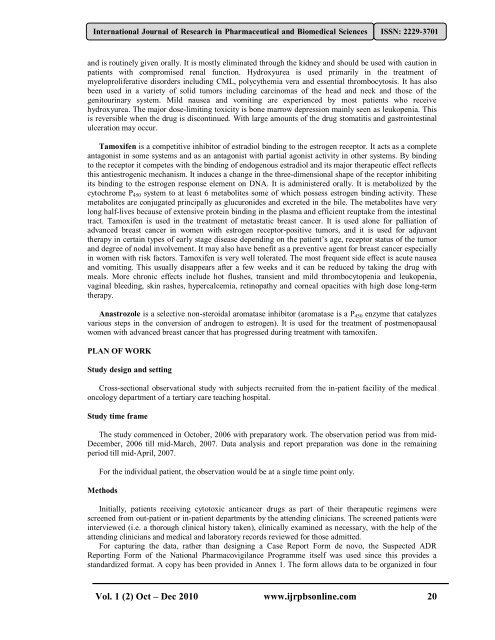Monitoring of Suspected Adverse Drug Reactions in Oncology Unit ...
Monitoring of Suspected Adverse Drug Reactions in Oncology Unit ...
Monitoring of Suspected Adverse Drug Reactions in Oncology Unit ...
Create successful ePaper yourself
Turn your PDF publications into a flip-book with our unique Google optimized e-Paper software.
International Journal <strong>of</strong> Research <strong>in</strong> Pharmaceutical and Biomedical Sciences ISSN: 2229-3701<br />
and is rout<strong>in</strong>ely given orally. It is mostly elim<strong>in</strong>ated through the kidney and should be used with caution <strong>in</strong><br />
patients with compromised renal function. Hydroxyurea is used primarily <strong>in</strong> the treatment <strong>of</strong><br />
myeloproliferative disorders <strong>in</strong>clud<strong>in</strong>g CML, polycythemia vera and essential thrombocytosis. It has also<br />
been used <strong>in</strong> a variety <strong>of</strong> solid tumors <strong>in</strong>clud<strong>in</strong>g carc<strong>in</strong>omas <strong>of</strong> the head and neck and those <strong>of</strong> the<br />
genitour<strong>in</strong>ary system. Mild nausea and vomit<strong>in</strong>g are experienced by most patients who receive<br />
hydroxyurea. The major dose-limit<strong>in</strong>g toxicity is bone marrow depression ma<strong>in</strong>ly seen as leukopenia. This<br />
is reversible when the drug is discont<strong>in</strong>ued. With large amounts <strong>of</strong> the drug stomatitis and gastro<strong>in</strong>test<strong>in</strong>al<br />
ulceration may occur.<br />
Tamoxifen is a competitive <strong>in</strong>hibitor <strong>of</strong> estradiol b<strong>in</strong>d<strong>in</strong>g to the estrogen receptor. It acts as a complete<br />
antagonist <strong>in</strong> some systems and as an antagonist with partial agonist activity <strong>in</strong> other systems. By b<strong>in</strong>d<strong>in</strong>g<br />
to the receptor it competes with the b<strong>in</strong>d<strong>in</strong>g <strong>of</strong> endogenous estradiol and its major therapeutic effect reflects<br />
this antiestrogenic mechanism. It <strong>in</strong>duces a change <strong>in</strong> the three-dimensional shape <strong>of</strong> the receptor <strong>in</strong>hibit<strong>in</strong>g<br />
its b<strong>in</strong>d<strong>in</strong>g to the estrogen response element on DNA. It is adm<strong>in</strong>istered orally. It is metabolized by the<br />
cytochrome P 450 system to at least 6 metabolites some <strong>of</strong> which possess estrogen b<strong>in</strong>d<strong>in</strong>g activity. These<br />
metabolites are conjugated pr<strong>in</strong>cipally as glucuronides and excreted <strong>in</strong> the bile. The metabolites have very<br />
long half-lives because <strong>of</strong> extensive prote<strong>in</strong> b<strong>in</strong>d<strong>in</strong>g <strong>in</strong> the plasma and efficient reuptake from the <strong>in</strong>test<strong>in</strong>al<br />
tract. Tamoxifen is used <strong>in</strong> the treatment <strong>of</strong> metastatic breast cancer. It is used alone for palliation <strong>of</strong><br />
advanced breast cancer <strong>in</strong> women with estrogen receptor-positive tumors, and it is used for adjuvant<br />
therapy <strong>in</strong> certa<strong>in</strong> types <strong>of</strong> early stage disease depend<strong>in</strong>g on the patient’s age, receptor status <strong>of</strong> the tumor<br />
and degree <strong>of</strong> nodal <strong>in</strong>volvement. It may also have benefit as a preventive agent for breast cancer especially<br />
<strong>in</strong> women with risk factors. Tamoxifen is very well tolerated. The most frequent side effect is acute nausea<br />
and vomit<strong>in</strong>g. This usually disappears after a few weeks and it can be reduced by tak<strong>in</strong>g the drug with<br />
meals. More chronic effects <strong>in</strong>clude hot flushes, transient and mild thrombocytopenia and leukopenia,<br />
vag<strong>in</strong>al bleed<strong>in</strong>g, sk<strong>in</strong> rashes, hypercalcemia, ret<strong>in</strong>opathy and corneal opacities with high dose long-term<br />
therapy.<br />
Anastrozole is a selective non-steroidal aromatase <strong>in</strong>hibitor (aromatase is a P 450 enzyme that catalyzes<br />
various steps <strong>in</strong> the conversion <strong>of</strong> androgen to estrogen). It is used for the treatment <strong>of</strong> postmenopausal<br />
women with advanced breast cancer that has progressed dur<strong>in</strong>g treatment with tamoxifen.<br />
PLAN OF WORK<br />
Study design and sett<strong>in</strong>g<br />
Cross-sectional observational study with subjects recruited from the <strong>in</strong>-patient facility <strong>of</strong> the medical<br />
oncology department <strong>of</strong> a tertiary care teach<strong>in</strong>g hospital.<br />
Study time frame<br />
The study commenced <strong>in</strong> October, 2006 with preparatory work. The observation period was from mid-<br />
December, 2006 till mid-March, 2007. Data analysis and report preparation was done <strong>in</strong> the rema<strong>in</strong><strong>in</strong>g<br />
period till mid-April, 2007.<br />
For the <strong>in</strong>dividual patient, the observation would be at a s<strong>in</strong>gle time po<strong>in</strong>t only.<br />
Methods<br />
Initially, patients receiv<strong>in</strong>g cytotoxic anticancer drugs as part <strong>of</strong> their therapeutic regimens were<br />
screened from out-patient or <strong>in</strong>-patient departments by the attend<strong>in</strong>g cl<strong>in</strong>icians. The screened patients were<br />
<strong>in</strong>terviewed (i.e. a thorough cl<strong>in</strong>ical history taken), cl<strong>in</strong>ically exam<strong>in</strong>ed as necessary, with the help <strong>of</strong> the<br />
attend<strong>in</strong>g cl<strong>in</strong>icians and medical and laboratory records reviewed for those admitted.<br />
For captur<strong>in</strong>g the data, rather than design<strong>in</strong>g a Case Report Form de novo, the <strong>Suspected</strong> ADR<br />
Report<strong>in</strong>g Form <strong>of</strong> the National Pharmacovigilance Programme itself was used s<strong>in</strong>ce this provides a<br />
standardized format. A copy has been provided <strong>in</strong> Annex 1. The form allows data to be organized <strong>in</strong> four<br />
Vol. 1 (2) Oct – Dec 2010 www.ijrpbsonl<strong>in</strong>e.com 20

















